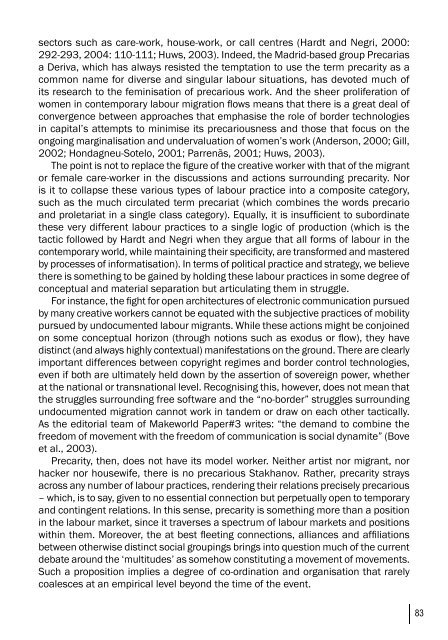art-e-conomy _ reader - marko stamenkovic
art-e-conomy _ reader - marko stamenkovic
art-e-conomy _ reader - marko stamenkovic
Create successful ePaper yourself
Turn your PDF publications into a flip-book with our unique Google optimized e-Paper software.
sectors such as care-work, house-work, or call centres (Hardt and Negri, 2000:<br />
292-293, 2004: 110-111; Huws, 2003). Indeed, the Madrid-based group Precarias<br />
a Deriva, which has always resisted the temptation to use the term precarity as a<br />
common name for diverse and singular labour situations, has devoted much of<br />
its research to the feminisation of precarious work. And the sheer proliferation of<br />
women in contemporary labour migration flows means that there is a great deal of<br />
convergence between approaches that emphasise the role of border technologies<br />
in capital’s attempts to minimise its precariousness and those that focus on the<br />
ongoing marginalisation and undervaluation of women’s work (Anderson, 2000; Gill,<br />
2002; Hondagneu-Sotelo, 2001; Parrenãs, 2001; Huws, 2003).<br />
The point is not to replace the figure of the creative worker with that of the migrant<br />
or female care-worker in the discussions and actions surrounding precarity. Nor<br />
is it to collapse these various types of labour practice into a composite category,<br />
such as the much circulated term precariat (which combines the words precario<br />
and proletariat in a single class category). Equally, it is insufficient to subordinate<br />
these very different labour practices to a single logic of production (which is the<br />
tactic followed by Hardt and Negri when they argue that all forms of labour in the<br />
contemporary world, while maintaining their specificity, are transformed and mastered<br />
by processes of informatisation). In terms of political practice and strategy, we believe<br />
there is something to be gained by holding these labour practices in some degree of<br />
conceptual and material separation but <strong>art</strong>iculating them in struggle.<br />
For instance, the fight for open architectures of electronic communication pursued<br />
by many creative workers cannot be equated with the subjective practices of mobility<br />
pursued by undocumented labour migrants. While these actions might be conjoined<br />
on some conceptual horizon (through notions such as exodus or flow), they have<br />
distinct (and always highly contextual) manifestations on the ground. There are clearly<br />
important differences between copyright regimes and border control technologies,<br />
even if both are ultimately held down by the assertion of sovereign power, whether<br />
at the national or transnational level. Recognising this, however, does not mean that<br />
the struggles surrounding free software and the “no-border” struggles surrounding<br />
undocumented migration cannot work in tandem or draw on each other tactically.<br />
As the editorial team of Makeworld Paper#3 writes: “the demand to combine the<br />
freedom of movement with the freedom of communication is social dynamite” (Bove<br />
et al., 2003).<br />
Precarity, then, does not have its model worker. Neither <strong>art</strong>ist nor migrant, nor<br />
hacker nor housewife, there is no precarious Stakhanov. Rather, precarity strays<br />
across any number of labour practices, rendering their relations precisely precarious<br />
– which, is to say, given to no essential connection but perpetually open to temporary<br />
and contingent relations. In this sense, precarity is something more than a position<br />
in the labour market, since it traverses a spectrum of labour markets and positions<br />
within them. Moreover, the at best fleeting connections, alliances and affiliations<br />
between otherwise distinct social groupings brings into question much of the current<br />
debate around the ‘multitudes’ as somehow constituting a movement of movements.<br />
Such a proposition implies a degree of co-ordination and organisation that rarely<br />
coalesces at an empirical level beyond the time of the event.<br />
83


